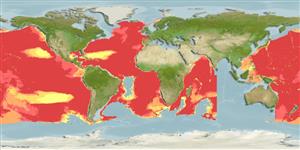>
Aulopiformes (Grinners) >
Evermannellidae (Sabertooth fishes)
Etymology: Odontostomops: Greek, odous = teeth + Greek, stoma = mouth + Greek, ops = appearance (Ref. 45335).
Environment: milieu / climate zone / depth range / distribution range
Ecologia
marino; distribuzione batimetrica 400 - 1000 m (Ref. 4478). Deep-water
Atlantic, Indian and Pacific: in tropical and subtropical waters. Absent in the Mediterranean and in the eastern tropical Pacific. Widespread in the Eastern Central Atlantic but recorded mainly between 5°N and south of the equator. South China Sea (Ref.74511).
Size / Peso / Age
Maturity: Lm ? range ? - ? cm
Max length : 12.3 cm SL maschio/sesso non determinato; (Ref. 4478)
Mesopelagic at ca. 100-1000 m (Ref. 58302). Larvae (<3 cm SL) and small juveniles are frequently caught in the upper 50 or 100 m. Most adults are usually taken from depths exceeding 400 m but often between 100-400 m (Ref. 4763). Feeds on other midwater fishes. Synchronous hermaphrodites (Ref. 4478).
Life cycle and mating behavior
Maturities | Riproduzione | Spawnings | Egg(s) | Fecundities | Larve
Johnson, R.K., 1990. Evermannellidae. p. 390-392. In J.C. Quero, J.C. Hureau, C. Karrer, A. Post and L. Saldanha (eds.) Check-list of the fishes of the eastern tropical Atlantic (CLOFETA). JNICT, Lisbon; SEI, Paris; and UNESCO, Paris. Vol. 1. (Ref. 4478)
IUCN Red List Status (Ref. 130435)
Threat to humans
Harmless
Human uses
Strumenti
Special reports
Download XML
Fonti Internet
Estimates based on models
Preferred temperature (Ref.
123201): 2.3 - 10.9, mean 7.7 °C (based on 619 cells).
Phylogenetic diversity index (Ref.
82804): PD
50 = 1.0039 [Uniqueness, from 0.5 = low to 2.0 = high].
Bayesian length-weight: a=0.00417 (0.00157 - 0.01110), b=3.12 (2.89 - 3.35), in cm total length, based on LWR estimates for this (Sub)family-body shape (Ref.
93245).
Trophic level (Ref.
69278): 4.3 ±0.60 se; based on food items.
Resilienza (Ref.
120179): Medio, tempo minimo di raddoppiamento della popolazione 1.4 - 4.4 anni (Assuming tmax>3).
Fishing Vulnerability (Ref.
59153): Low vulnerability (10 of 100).
